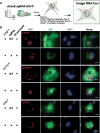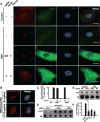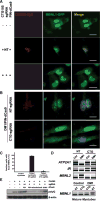Elimination of Toxic Microsatellite Repeat Expansion RNA by RNA-Targeting Cas9
- PMID: 28803727
- PMCID: PMC5873302
- DOI: 10.1016/j.cell.2017.07.010
Elimination of Toxic Microsatellite Repeat Expansion RNA by RNA-Targeting Cas9
Abstract
Microsatellite repeat expansions in DNA produce pathogenic RNA species that cause dominantly inherited diseases such as myotonic dystrophy type 1 and 2 (DM1/2), Huntington's disease, and C9orf72-linked amyotrophic lateral sclerosis (C9-ALS). Means to target these repetitive RNAs are required for diagnostic and therapeutic purposes. Here, we describe the development of a programmable CRISPR system capable of specifically visualizing and eliminating these toxic RNAs. We observe specific targeting and efficient elimination of microsatellite repeat expansion RNAs both when exogenously expressed and in patient cells. Importantly, RNA-targeting Cas9 (RCas9) reverses hallmark features of disease including elimination of RNA foci among all conditions studied (DM1, DM2, C9-ALS, polyglutamine diseases), reduction of polyglutamine protein products, relocalization of repeat-bound proteins to resemble healthy controls, and efficient reversal of DM1-associated splicing abnormalities in patient myotubes. Finally, we report a truncated RCas9 system compatible with adeno-associated viral packaging. This effort highlights the potential of RCas9 for human therapeutics.
Keywords: ALS; CRISPR; Huntington’s disease; RNA-targeting Cas9; adeno-associated virus; gene therapy; microsatellite repeat expansion; minimal Cas9; myotonic dystrophy.
Copyright © 2017 Elsevier Inc. All rights reserved.
Figures







Comment in
-
A Therapeutic Double Whammy: Transcriptional or Post-transcriptional Suppression of Microsatellite Repeat Toxicity by Cas9.Mol Cell. 2017 Nov 2;68(3):473-475. doi: 10.1016/j.molcel.2017.10.023. Mol Cell. 2017. PMID: 29100050
References
MeSH terms
Substances
Grants and funding
LinkOut - more resources
Full Text Sources
Other Literature Sources
Medical
Molecular Biology Databases
Research Materials
Miscellaneous

